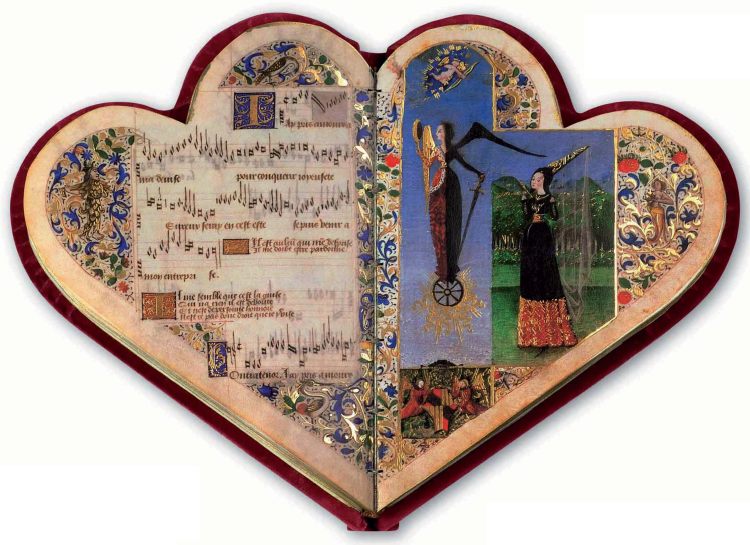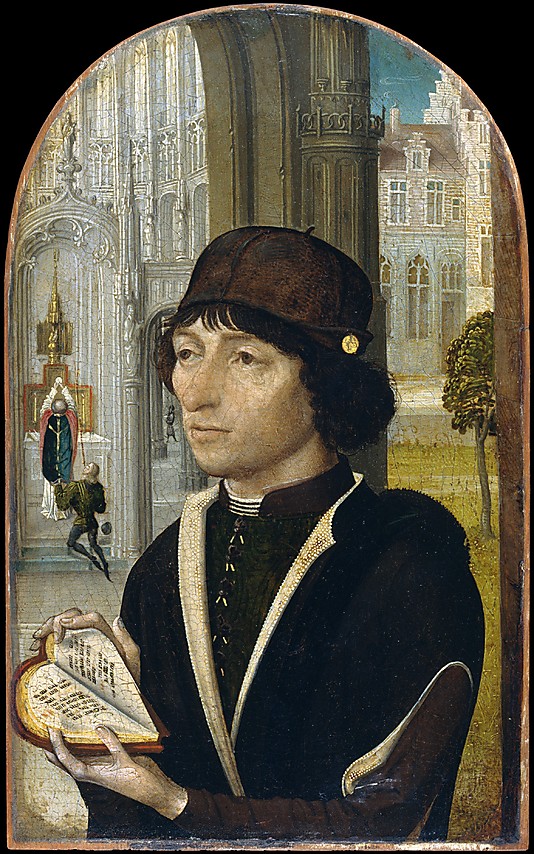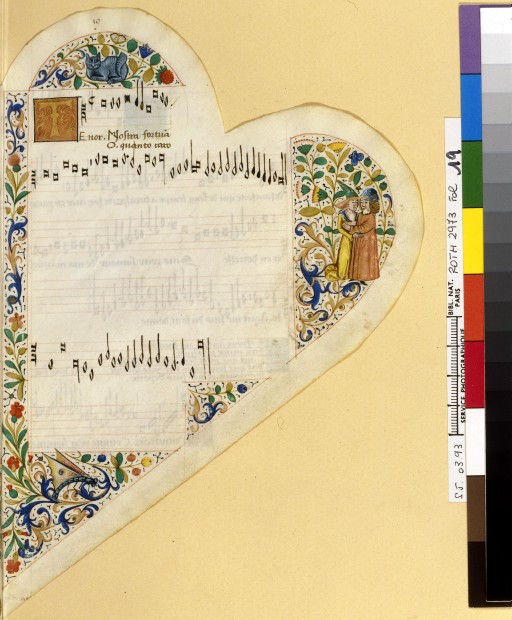A bad bishop’s book of love songs. Despite some gaping character flaws, French cleric Jean de Montchenu had good taste in illuminated manuscripts. Its not the Limbourg Brothers Tres Riches Heures, but it is the sole known surviving manuscript that is in the shape of a single heart when closed and of two joined hearts when opened.

Read More:http://www.omifacsimiles.com/brochures/montchen.html ---This exceptional MS, closed, is shaped like a heart; when open it becomes two hearts joined, representing two lovers who send love messages to one another in each one of the songs. When the word “heart” appears in the texts, it is represented by a pictogram. Two full-page illustrations appear in the codex. In the first, Cupid throws arrows at a young girl while at his side Fortune spins his wheel.---
Now indeed can I cry ‘alas’
and flood my eyes with tears
for I can no longer see her
as I used to, woe is me.
No indeed can I cry ‘alas’.
O accursed tongue, evil and sinful,
that caused me so much pain,
you have brought me to such straits that
life has become a misery.
Now indeed can I cry ‘alas’.
If I cannot believe that I shall ever again
see my dear treasure as I used to,
with a golden noose
around my neck my life shall end.
Now indeed can I cry ‘alas’….

Read More:http://www.metmuseum.org/Collections/search-the-collections/110001476 ---The sitters for this panel and a very similar one in the National Gallery, London, wear distinctive, nearly identical costumes, and we can therefore assume that they were members of the same organization—perhaps a guild or confraternity. The Brussels church of Sainte Gudule is featured in the background, exemplifying the local pride characteristic of artists and patrons at the time.---
Jean de Montchenu, to whom the charming “chansonnier” owes its existence, was described as “a great scoundrel of shameful conduct, lewd, detestable, dissolute, and full of vices.” Born of a noble family, he took holy orders at an early age, and in 1460 was assigned to the fairly important position of apostolic prothhonotary. Ten years later he became head of an abbey in Piedmont, a lucrative post that probably enabled him to afford the songbook.

Read More:http://kittybriton.multiply.com/photos/photo/10/1?&show_interstitial=1&u=%2Fphotos%2Fphoto ---This heart-shaped songbook -- the Chansonnier Cordiforme, also known as the Chansonnier de Jean de Montchenu... , consists of seventy-two parchment folios, in a heart shaped leather binding that opens to a double heart shape.. Since the late nineteenth century, when it was acquired by the Baron Henri de Rothschild, this rarity has been famous among musicologists and historians of the book.---
He involved himself in political intrigues: first supporting Burgundy against France, and later supporting France against Burgundy. As a secret agent for Louis XI, he connived to eliminate Burgundian influence at the Court of Savoy. His methods were not particularly subtle: he had the Burgundian secret agent dragged out of bed, bound hand and foot, and carried off to France. He seems to have managed to stay in favor with Louis XI for the rest of his life, and in 1477 the pope made him a bishop. But ars longa, vita brevis: all that remains of the bad bishop is his excellent songbook.
ADDENDUM:
( see link at end) …Of all medieval music manuscripts the Chansonnier Cordiforme lays the strongest claim to the privilege of being recorded complete – not so much because of its extraordinary visual beauty and its unique heart-shaped
pages, but because of its date and repertory. The manuscript was compiled in the early 1470s, at a time when the medieval song tradition stretching back some 150 years was at its ripest. In 1474 Guillaume Dufay died after a long and distinguished career in which he had towered above all his colleagues: practically everything in the Chansonnier Cordiforme shows the influence of this greatest of all medieval composers. His two major contemporaries, Dunstable
and Binchois, had died 21 and 14 years earlier respectively. Chief among the rising generation were Ockeghem, Busnoys and Hayne van Ghizeghem, all three just beginning to achieve international fame when the manuscript was made. With the next generation, composers such as Josquin, Obrecht and Isaac were to discard the old style and introduce a manner of counterpoint in which each voice aimed to be functionally equal. The Chansonnier Cordiforme is perhaps the last collection devoted entirely to the old style; and with some 13-15 different composers represented it gives examples of many different approaches. No significant composer of the time is absent from the manuscript….
…The owner of the manuscript is known from the coat of arms on the first page. He was Jean de Montchenu, bishop, politician and warrior, a man who seems characteristic of an age when the outrageous worldliness of certain clergy made the reformation almost inevitable. An early chronicler described him as ‘a great scoundre
hameful of conduct, highly unchaste, detestable, dissolute and full of vices’….…What makes Savoy a particularly important and characteristic centre for surveying this repertory, however, is that it straddles France and Italy thereby having access to a far broader and more representative range of music than did Burgundy. Jean de Montchenu’s chansonnier is the only song manuscript known to come from French Savoy during the fifteenth century; and it is therefore no surprise that it should contain more than any other manuscript, the finest examples of the song traditions from both sides of the Alps…. Read More:http://www.buywell.com/booklets/4801819.pdf






 COMMENTS
COMMENTS
We are the publishers of the facsimile edition of the Chansonnier de Jean de Montchenu. Thank you for your article. We invite you to visit our web and enjoy with more images: http://www.vgesa.com/facsimile-codex-chansonnier_montchenu.htm
You can also visit our Facebook page, where you can know the making proccess of the facsimile edition: https://www.facebook.com/vicent.editores
Sincerely yours,
Fernando.